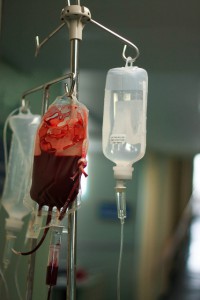
What time is the right time to give a transfusion? Doctors at Boston Children's are turning a fresh eye on transfusion guidelines for children. (@alviseni/Flickr)
Cancer. Trauma. Sickle cell disease. Surgery. There are many reasons why a child might need a blood transfusion, but they all share a common theme: the need to replace blood or blood products (e.g., red blood cells, platelets) that have been lost or consumed, or make up for defects that keep the body from producing them in adequate amounts.
And though transfusions can be life saving, they come with risks, such as iron overload, inflammation or disease (a very low risk, thanks to improved screening tests). And blood products are expensive and scarce—another reason to be prudent about transfusions.
“There’s little science behind physicians’ current practices when deciding when to transfuse a patient,” says Jenifer Lightdale, MD, MPH, of Boston Children’s Hospital’s Division of Gastroenterology and Nutrition. “Many doctors use criteria their mentors passed down to them, which their mentors passed down to them, and so on. But ideally, the decision should be based on evidence, not tradition.”
Lightdale was part of a multidisciplinary team of Boston Children’s doctors and nurses that worked to review that evidence and convince doctors to change their thinking about transfusions. Called PRUDENT (for Patient Resource Use—Determination of Effective and Necessary Targets), the team—drawn from the hospital’s Division of Critical Care Medicine, Blood Bank and other departments, as well as Dana-Farber/Children’s Hospital Cancer Center (DF/CHCC)—took a hard initial look at transfusion practices across the hospital to develop better, evidence-based, cost-effective criteria that improve the quality of care.
PRUDENT had particular impact on DF/CHCC’s Stem Cell Transplant Program, where the team worked with the program’s Clinical Director, Leslie Lehmann, MD, on red blood cell (RBCs) transfusions for bone marrow transplant patients. These patients often receive RBC transfusions while recovering from their transplants.
“We showed that for children who were otherwise clinically stable, you could wait to give a transfusion until their hemoglobin count was 7 grams per deciliter (g/dL) of blood, rather than the current threshold of 9,” says Lightdale. “The new threshold is a conservative one that’s been proven safe in rigorously designed clinical trials, but it hadn’t been implemented in most of our departments or services.”
The team reported late last year in Biology of Blood and Marrow Transplantation that the change in threshold didn’t affect how long patients stayed in the hospital, how long it took for their transplanted stem cells to take, or mortality. “We did, however, reduce the number of units transfused and transfusion days per patient,” Lightdale says. “The cost of care was lower, too. Charges for blood products averaged $3,624 per patient at the 9 g/dL threshold, but were $2,185 at 7 g/dL, a 40 percent reduction.”
“There’s little science behind physicians’ current practices when deciding when to transfuse a patient. Many doctors use criteria their mentors passed down to them, which their mentors passed down to them, and so on.”
The PRUDENT team has not been alone in taking a critical look at blood product use at Boston Children’s. Last week, Martha Sola-Visner, MD, of Boston Children’s Division of Newborn Medicine, reported at the Pediatric Academic Societies meeting in Boston the results of a multicenter, retrospective study of platelet transfusions in premature infants. “Premature babies often have thrombocytopenia, or low platelet counts, which can put them at risk for bleeding in the brain,” she says. “But no one has looked at the guidelines for platelet transfusions in these children for 20 years.”
Sola-Visner’s study reveals that premature babies born at very low birth weights often receive transfusions at platelet counts between 51,000 and 100,000 per microliter of blood, levels indicating mild to moderate thrombocytopenia. “However,” she states, “there is no scientific evidence supporting the benefit of giving platelets at these levels.” She is designing a new prospective trial aimed at finding out whether doctors can safely wait until the infants’ platelet counts are lower before transfusing.
In addition, Steven Sloan, MD, PhD, the Blood Bank’s medical director and a member of the PRUDENT team, notes that Boston Children’s transfusion committee has long kept a watchful eye on blood product use. “We review on a case-by-case basis any instances when a transfusion may have been inappropriate,” he says. “We also look for areas for improvement, like eliminating practice variations or reusing a patient’s own blood during surgery. It’s all about doing the right thing for our patients.”







